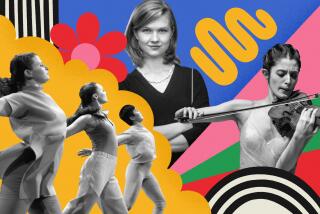More Early Americana on CDs
- Share via
What ever happened to Charles Ives? Twenty-some years ago he was declared “the Washington, Jefferson and Lincoln of American music” by Leonard Bernstein. Ives was everywhere: on concert programs, on recordings, even on network television. How could Americans resist a cranky, reclusive, creative genius who amassed a fortune as an insurance executive?
It worked, as long as Bernstein was beating the drums. When he went on to pursue other interests--e.g., respectability--Ives’ star declined. Subsequent, less passionate assessment showed Ives to be many of the things the hypesters claimed, but also the composer of a complex, hardly always accessible body of work less suited to the popular taste than had been supposed.
A second rediscovery is in order, and one can begin with a pair of new recordings, each showing a degree of patience and interpretive subtlety rarely encountered during the rush-to-market Ivesmania of the 1960s.
First, Michael Tilson Thomas and the Chicago Symphony offer (on CBS 42381) a richly detailed, immaculately executed reading of the “Holidays Symphony”--in fact, four independent tone poems, all written before World War I: “Washington’s Birthday” (with its notorious Jew’s harp solo), “Decoration Day,” “The Fourth of July” and “Thanksgiving.”
“Central Park in the Dark”--another polytonal impressionist essay--and two different versions of the moody, broody “Unanswered Question” (1906) are also included in the CBS program.
The second release is of a work largely ignored during the first Ives revival, his 1904 Piano Trio, and it is available from the mail-order Musical Heritage Society (14 Park Road, Tinton Falls, N.J. 07724).
The Trio is Ivesian to a fault in its free tonality and use of traditional melodies in raucous juxtaposition. It is also music of solemn grandeur, requiring the three instruments to produce quasi-orchestral sonorities. The task falls well within the capabilities of the excellent Toledo Trio (as in Toledo, Ohio): pianist Frances Renzi, violinist Kirk Toth and cellist Steven Elisha.
Ives’ Trio serves as centerpiece of an intelligently assembled program (MHS 5122883) where it is contrasted with the conservative--but by no means unimaginative--works of two other New England composers, H.H.A. Beach and Horatio Parker, the latter Ives’ composition teacher at Yale.
Samuel Barber’s ‘30s through ‘40s American Romanticism would seem to be finding an enthusiastic new generation of interpreters, led by Leonard Slatkin and his St. Louis Symphony. Their lively, handsomely executed new Barber recording (EMI/Angel 49463) includes some of his most characteristic works: the Overture to “The School for Scandal,” the Three Essays, Adagio for Strings, and the tougher, more dissonant “Medea’s Dance of Vengeance.”
The CD debut of Barber’s 1947 masterpiece, “Knoxville, Summer of 1915,” a setting of childhood reminiscences by poet James Agee, has been entrusted to soprano Dawn Upshaw and New York’s Orchestra of St. Luke’s led by David Zinman (Nonesuch 9187).
While Upshaw’s marksmanship is unassailable, her sweet, lightweight instrument and almost consonantless enunciation leave an impression of blandness. It is unlikely that anyone familiar with the original “Knoxville” recording by Eleanor Steber or the even more lushly sensuous one by Leontyne Price (both await CD reissue) will be satisfied with Upshaw’s girl-next-door version, in spite of being part of a compelling program that also includes arias from Menotti’s “Old Maid and the Thief” and Stravinsky’s “Rake’s Progress,” and the “Mirabai Songs” of John Harbison (Nonesuch 9187).
More to Read
The biggest entertainment stories
Get our big stories about Hollywood, film, television, music, arts, culture and more right in your inbox as soon as they publish.
You may occasionally receive promotional content from the Los Angeles Times.









